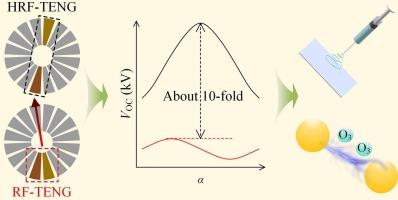具有新型电极对相对位置的高压旋转独立式摩擦纳米发电机:理论与实验研究
IF 7.9
2区 材料科学
Q1 MATERIALS SCIENCE, MULTIDISCIPLINARY
引用次数: 0
摘要
摩擦纳米发电机作为一种理想的高压源在高压设备中得到了广泛的应用。但是,仍然存在一些超出传统TENG电压范围的高压应用需求。在此,我们提出了一种结构简单的高压旋转独立式TENG (HRF-TENG)。受传统RF-TENG有限元计算的启发,通过改变传统RF-TENG中电极对的相对位置(减小电容)获得了HRF-TENG器件。通过有限元计算和实验对高压机理进行了初步研究,在500rpm转速下计算出的输出电压可达30kv以上。此外,无论旋转方向如何,当前方向保持不变。HRF-TENG产生的超高电压足以击穿气隙产生臭氧,从而实现臭氧饮用水灭菌系统。含有107 CFU/ml大肠杆菌和金黄色葡萄球菌的饮用水分别可在24 min和28 min内完全灭菌。同时,静电纺丝系统可以直接由HRF-TENG驱动,无需任何电路。所有这些演示都证明了HRF-TENG在高压应用领域的可行性。总之,这项工作为设计高压应用的teng提供了有用的指导。本文章由计算机程序翻译,如有差异,请以英文原文为准。

High voltage rotary freestanding triboelectric nanogenerator with novel electrode pair relative position: Theoretical and experimental studies
Triboelectric nanogenerators (TENGs) are widely used as ideal high-voltage sources in high-voltage equipment. However, there are still some high-voltage application demands that exceed the voltage range of traditional TENG. Here, we propose a high-voltage rotary freestanding TENG (HRF-TENG) with a simple structure. The HRF-TENG device is obtained by changing the relative positions of the electrode pairs (reducing the capacitance) in the traditional RF-TENG, which is inspired by the finite element (FEM) calculation of the traditional RF-TENG. The high-voltage mechanism is initially studied through FEM calculation and experiments, and the calculated output voltage can reach over 30 kV at 500 rpm. In addition, the current direction remains unchanged regardless of the rotation direction. The ultrahigh voltage from HRF-TENG is sufficient to break down the air gap to generate ozone, which achieves the ozone drinking water sterilization system. Drinking water containing 107 CFU/ml of E. coli and S. aureus can be completely sterilized within 24 min and 28 min, respectively. Meanwhile, the electrospinning system can be directly driven by HRF-TENG without any circuit. All of these demonstrations prove the feasibility of HRF-TENG in the field of high-voltage applications. In summary, this work provides useful guidance for designing TENGs for high-voltage applications.
求助全文
通过发布文献求助,成功后即可免费获取论文全文。
去求助
来源期刊

Materials & Design
Engineering-Mechanical Engineering
CiteScore
14.30
自引率
7.10%
发文量
1028
审稿时长
85 days
期刊介绍:
Materials and Design is a multi-disciplinary journal that publishes original research reports, review articles, and express communications. The journal focuses on studying the structure and properties of inorganic and organic materials, advancements in synthesis, processing, characterization, and testing, the design of materials and engineering systems, and their applications in technology. It aims to bring together various aspects of materials science, engineering, physics, and chemistry.
The journal explores themes ranging from materials to design and aims to reveal the connections between natural and artificial materials, as well as experiment and modeling. Manuscripts submitted to Materials and Design should contain elements of discovery and surprise, as they often contribute new insights into the architecture and function of matter.
 求助内容:
求助内容: 应助结果提醒方式:
应助结果提醒方式:


